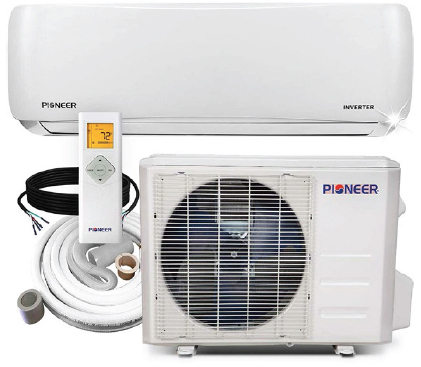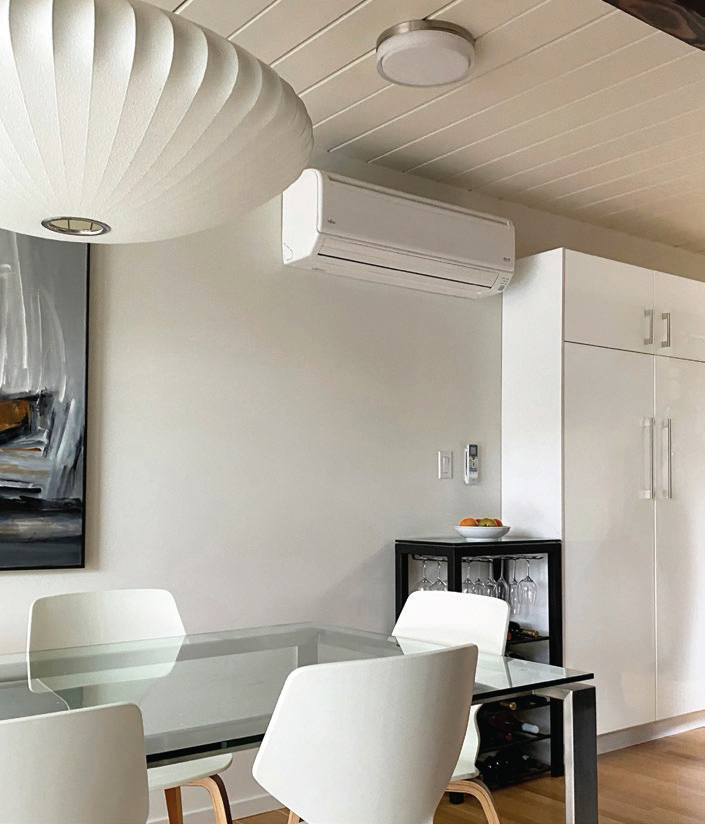Rise of the Mini-split
 |
|
|
California's weather has become more unpredictable than ever in recent years, with heat, cold, and smoke from fires often leaving us feeling as though being comfortable inside our own homes is simply too much to expect.
Between these changing weather conditions and increasing numbers of people working from home offices, ensuring that we have efficient heating and air conditioning has become a higher priority than ever.
Fortunately, most Eichler homeowners still enjoy the cozy comfort of radiant heating. But for those who don't, those whose original radiant systems are corroding beyond repair, and those whose needs have grown, what are the viable options for replacing an Eichler's existing radiant heating, or even supplementing a working system in a targeted and cost- and energy-efficient way?
The most common Eichler replacement solutions available today are in-floor hydronic radiant heat systems, hydronic and electric baseboard systems, and high-velocity/low-profile duct systems, such as the electric Unico System, which, unlike the other two, provides a cooling feature in addition to heating.
A progressive fourth player on the replacement scene is electric 'ductless mini-split' technology, which, in recent years, has experienced booming popularity with a reputation as a reliable and cost- and energy-efficient form of both heating and air conditioning. Mini-splits operate on demand, without gas, and without central ductwork, and appear to have certain advantages over conventional HVAC systems.
Each system has its own set of benefits and drawbacks.
 |
Newfound popularity
"You're talking to an old-timer here," says Mike Rebholtz, owner of Alternative HVAC Solutions in San Carlos, while raving about the mini-split's impact on his world. "I've done this for 48 years, and these systems have gotten me all energized again.
"What's more, mini-splits have gone ballistic for our business. We've grown 40 percent because of them. They've gone from comprising 50 percent of our business to 75 percent."
"Mini-split systems have definitely changed our business," chimes in Angel Sainz, owner of Ventwerx HVAC Air Conditioning and Heating, based in the San Jose area. Sainz expects that in the HVAC industry, the future will certainly continue to lean towards heat pump technology, which is at the heart of the mini-split.
"These systems operate by a reversing pump that turns hot air into cold, and cold into hot," he says. "They heat and cool, and have a very efficient design, with rotary compressors instead of standard compressors like a traditional air-conditioning system has."
"In the Eichler world, a ductless system is a beautiful thing," adds Sainz. "A standard home gives you areas to hide the HVAC [ductwork], but not an Eichler."
 |
Mini-split's Asian roots
In 1968, Mitsubishi in Japan revolutionized the HVAC world when they introduced the wall-mounted split-system room air conditioner featuring a line flow fan. Daikin and Toshiba were also early innovators of this technology.
"The concept of a ductless DX [direct expansion cooling] air-conditioning system that is familiar in the world today has gradually evolved since being introduced en mass...," according to the HVAC industry periodical The News.
The original goal of this type of system, The News continued, was to be able to introduce spot, targeted cooling to homes and buildings "where a more complete, whole-system approach was unfeasible due to either space or financial constraints, but ultimately served as a much friendlier cooling—and now more common heating—solution…"
"I bought my house in 1987, and put in my own mini-split unit over 25 years ago," says Rebholtz. "But they're a lot older than that. In Asia and Europe, they're way ahead of us in trying to reduce our carbon footprint."
But why is it that we haven't heard much about these systems in the U.S. until the past two decades? "In part," says Sainz, "because our style of building homes [here in the U.S.] is different than in Southeast Asia and parts of Europe. In those areas, houses don't have the attics and crawlspaces we have here. There, mini-splits have been the technology for many, many years."




